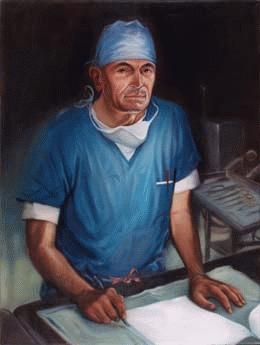On October 27, 1967, Dr. Lester R. Sauvage (1926-2015), founder of the Hope Heart Institute in Seattle, performs the first “bloodless” open-heart surgery in the Northwest on a patient whose religious beliefs preclude the acceptance of blood transfusions. The patient, 18-year-old Bernice Goldstien of Bainbridge Island, survived the operation and eventually helped establish transfusion-free surgical programs at several hospitals in Washington state.
Goldstien, a Jehovah’s Witness, was diagnosed in childhood with a congenital heart valve defect. Doctors first proposed surgery for her when she was age 5, but her mother -- also a Jehovah’s Witness -- refused on religious grounds. (Jehovah’s Witnesses believe that the Bible prohibits the acceptance of transfused blood or blood products.) Two years later, her doctors again recommended surgery, at one point threatening to get a court order to force compliance, but her mother still refused.
By the time she was in her late teens, Goldstien’s defective valve had seriously weakened her heart. She began to consider surgery, but wanted a surgeon who would operate without giving her a transfusion. Even when she was young, she says, she was "very firm and determined" not to accept blood (Tri-City Herald).
A physician at Children’s Hospital recommended Sauvage, who, by 1967, was becoming one of Seattle’s best-known cardiovascular surgeons. Sauvage initially refused to operate, saying it would be too risky to break open a patient’s chest, stop the heart, cut into it, and repair it without the margin of safety provided by transfusion. At the time, a typical heart operation involved the transfusion of two to four pints of blood, four or more pints of plasma and six to twelve units of platelets. Additional blood was needed to prime the heart-lung machine, which kept the patient alive during the operation.
A devout Catholic and deeply spiritual himself, Sauvage eventually decided to proceed with the surgery out of respect for Goldstien’s religious faith. He agreed not to give her a transfusion even if, during the course of the surgery, he thought one might be necessary to save her life. "He told me, ‘If you’re willing to risk this surgery, I’m willing to risk it too,’ " she says. "He understood how important my spiritual values were" (Goldstien interview).
The operation was performed at Providence Hospital (now part of Swedish Medical Center). Before beginning the surgery, Sauvage primed the heart-lung machine with a saline solution instead of blood. He also took a number of steps to minimize the amount of blood lost on the operating table. As a result, Goldstien lost only half a pint of blood. She left the hospital, fully recovered, 12 days later, and has had no problems with her heart since then.
Goldstien later became an active supporter of transfusion-free surgery. In 1994, she helped establish a "bloodless surgery" program at Kadlec Medical Center in Richland. Four years later, she established a similar program at Providence Medical Center (now Swedish Medical Center) in Seattle, where Sauvage had operated on her 31 years earlier. She retired as manager of that program in 2004.
Sauvage went on to perform many other heart surgeries without using donated blood for patients who asked for that option. He said later that he "liked the challenge of doing heart surgery that way." Most of his no-transfusion patients were Jehovah’s Witnesses who refused the blood for religious reasons. However, by the time he retired from his clinical practice, in 1991, he was seeing more interest from patients who were concerned about the risk of contracting HIV/AIDS, hepatitis, and other infections from transfusions. Although such risks are very low, "if a member of my family or I were to require open-heart surgery, I would make such a request too," he said (Sauvage, 229-230).
Today there are about 100 recognized bloodless programs in medical centers around the country. New drugs, methods, and machines reduce blood loss on the operating table. Blood centers support such efforts because they take pressure off the blood supply. "The steps to avoid transfusions turn out to be a benefit to everyone," Goldstien said (Seattle Post-Intelligencer).

